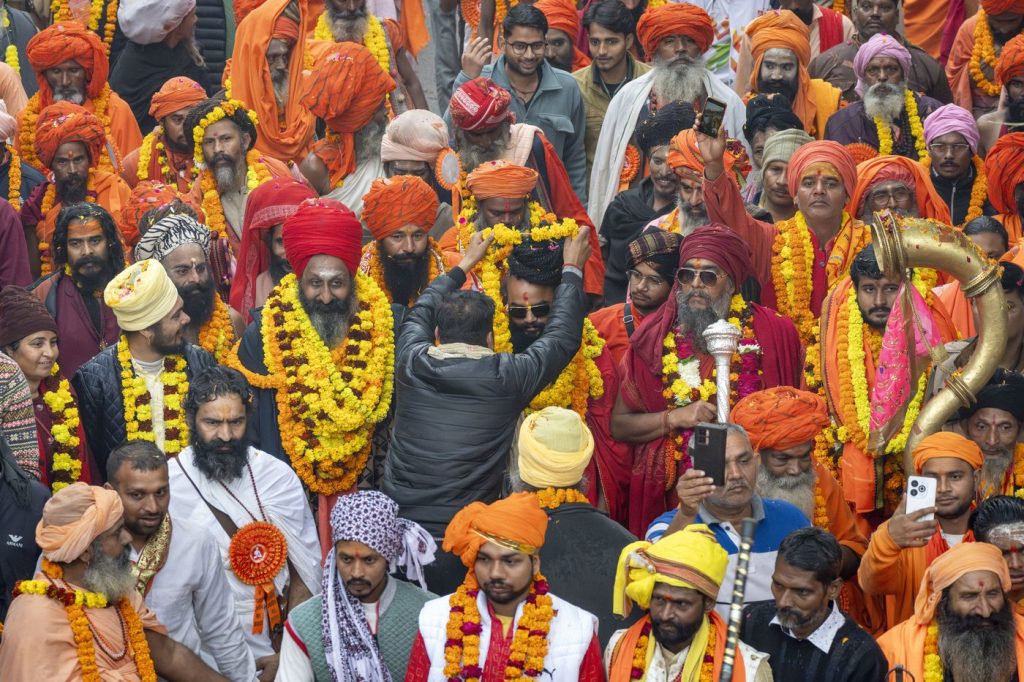PRAYAGRAJ, India (AP) – Millions of Hindu devotees, mystics, and holy individuals from across India descended upon the northern city of Prayagraj on Monday to inaugurate the Maha Kumbh festival, heralded as the world's largest religious gathering. This grand event, set to last for approximately six weeks, takes place at the confluence of three revered rivers: the Ganges, the Yamuna, and the mythical Saraswati. Participants engage in intricate rituals with the hope of embarking on a journey to achieve the ultimate goal of Hindu philosophy: liberation from the cycle of rebirth.
The veneration of rivers is a significant aspect of Hinduism, particularly the Ganges and the Yamuna, as followers believe that bathing in their waters purifies them of past sins and liberates them from reincarnation, especially on auspicious days. The most significant bathing events occur during the Maha Kumbh Mela, known as the pitcher festival, which takes place every 12 years. The festival's history dates back to medieval times, and the bathing ceremonies are rooted in the belief that drops of the nectar of immortality fell in Prayagraj, alongside other locations: Nasik, Ujjain, and Haridwar.
Daily bathing rituals are an integral part of the festival, with the most auspicious days drawing naked, ash-smeared monks rushing towards the holy rivers at dawn. Many pilgrims remain throughout the festival, practicing austerity, offering alms, and bathing at sunrise each day. “We feel peaceful here and attain salvation from the cycles of life and death,” expressed Bhagwat Prasad Tiwari, a devout pilgrim.
The Kumbh festival operates on a rotation every three years among the aforementioned four sacred sites, with the current festivities in Prayagraj being the grandest to date. The last smaller Ardh Kumbh festival in 2019 saw around 240 million visitors, with approximately 50 million participating in ritual bathing on the peak day.
This year’s Maha Kumbh is anticipated to attract at least 400 million people over 45 days, equating to more than the population of the United States. This figure is nearly 200 times greater than the 2 million pilgrims that attended last year's Hajj in Saudi Arabia. Consequently, the festival presents a significant challenge for Indian authorities, showcasing Hindu culture, tourism, and crowd management.
A vast area along the riverbanks has been converted into a sprawling tent city, complete with over 3,000 kitchens and 150,000 bathrooms. The tent city spans 40 square kilometers (15 square miles), is divided into 25 sections, and features essential amenities including housing, roads, electricity, water services, communication towers, and 11 hospitals. Murals illustrating stories from Hindu scriptures adorn the walls of the tent city.
To facilitate transportation, Indian Railways has introduced over 90 special trains, collectively making nearly 3,300 trips during the festival in addition to regular services. Moreover, approximately 50,000 security personnel—an increase of 50% compared to 2019—are deployed to ensure safety and manage the massive crowds. Over 2,500 surveillance cameras, some using artificial intelligence, will provide real-time data on crowd movements, allowing for quick responses to avoid any dangerous situations.
The festival also serves as a political platform, with India's leaders historically leveraging it to solidify their relationships with the predominantly Hindu population, which constitutes about 80% of the nation’s 1.4 billion people. Under Prime Minister Narendra Modi, the Maha Kumbh has become a powerful illustration of the advocacy for Hindu nationalism. Modi's administration views Indian civilization as inseparable from Hindu identity, although critics argue the political philosophy is rooted in Hindu supremacy.
The Uttar Pradesh state government, headed by Adityanath—a prominent Hindu monk and right-wing politician in Modi’s party—has allocated over $765 million for this year's event to enhance both his and Modi’s public image. The city is adorned with giant billboards and posters showcasing the leaders and their welfare policies, reflecting their connection to the religious observance.
Recent gatherings of the Kumbh festival have sparked controversies, such as Modi’s administration renaming Allahabad to Prayagraj as part of a broader effort to change names from Muslim to Hindu references in the lead-up to the 2019 festival and national elections. Additionally, despite rising COVID-19 cases, the government insisted on proceeding with the Kumbh event in Haridwar in 2021, fearing backlash from religious leaders in the Hindu-majority nation.










